The Avenue of the Saints is a 563-mile-long (906 km) highway in the Midwestern United States that connects St. Louis, Missouri, and St. Paul, Minnesota.

Iowa Highway 17 is a 103-mile-long (166 km) north–south state highway that traverses primarily rural areas in central and north-central Iowa. Iowa 17's southern end is near Granger in Dallas County at a freeway interchange with Iowa Highway 141, and its northern terminus is at an intersection with U.S. Highway 18 at the Kossuth-Hancock county line near Wesley.

Interstate 235 (I-235) in Iowa is an auxiliary Interstate Highway that runs just north of downtown Des Moines through the heart of the Des Moines metropolitan area. I-235 runs from the junction of I-35 and I-80 in West Des Moines to the separation of the same two Interstates in Ankeny. The highway is approximately 14 miles (23 km) long.

Iowa Highway 3 (Iowa 3) is a state highway that runs from east to west across the state of Iowa. It is the longest state highway in Iowa, at 323 miles (520 km) long. Iowa 3 begins at the South Dakota state line where it continues as South Dakota Highway 50 and ends at the Northwest Arterial at the Dubuque city limits. It is designated the American Veterans Memorial Highway for its entirety. It is located approximately halfway between Interstate 80 and Interstate 90.

Iowa Highway 4 is a state highway which runs from north to south across the state of Iowa. It is 146 miles (235 km) long, beginning at an intersection with Iowa Highway 44 in Panora and ending at the Minnesota state line north of Estherville. It continues north as Minnesota State Highway 4. The route was created on January 1, 1969, when several route designations were changed to match other states' route numbers. Before 1969, Iowa 4 was known as Iowa 17.

Iowa Highway 92 (Iowa 92) is a state highway that runs from east to west across the state of Iowa. Iowa 92 is 279 miles (449 km) long and is part of a continuous 886-mile (1,426 km) four-state "Highway 92" which begins in Torrington, Wyoming, goes through Nebraska and Iowa and ends in La Moille, Illinois. It begins at the Missouri River in Council Bluffs, where it is a continuation of Nebraska Highway 92. It stretches across the state and serves to roughly demarcate the southern one-third of Iowa. It ends at the Mississippi River in Muscatine where it continues into Illinois as Illinois Route 92. Iowa 92 was designated in 1939 replacing the entirety of the original Iowa 2.
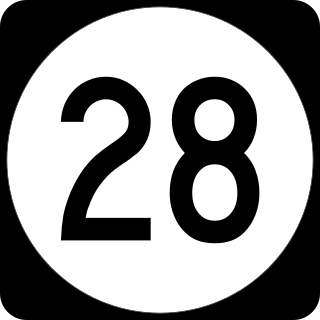
Iowa Highway 28 is a 21.73-mile-long (34.97 km) state highway located in south central Iowa. The route begins at Iowa Highway 92 at Martensdale and ends at Interstate 35 / Interstate 80 in Johnston. It is the first major north–south highway east of Interstate 35 in the Des Moines metropolitan area.

Iowa Highway 1 (Iowa 1) is a state highway in the U.S. state of Iowa that extends from Keosauqua to Anamosa. It travels nearly 120 miles (190 km), mainly through rich farmland and small communities. Iowa 1 provides an important link to Iowa City and the University of Iowa as it passes through campus. Portions of the route today date back to the late 1830s, when Martin Van Buren was president, making Iowa 1 one of the oldest routes in the state, pre-dating the current primary highway system by nearly eighty years. The highway was seriously damaged by the Cedar River in the Iowa flood of 2008, which closed the highway for seven weeks.
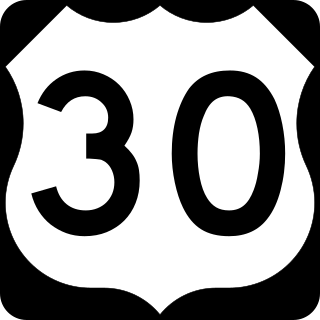
U.S. Highway 30 (US 30) is a major east–west U.S. Highway which spans 330 miles (530 km) across the state of Iowa. It is the longest primary highway in the state and is maintained by the Iowa Department of Transportation. The route in Iowa begins at the Missouri River crossing at Blair, Nebraska, and ends at the Mississippi River crossing at Clinton, Iowa. Along the way, it serves Denison and Carroll in western Iowa, Boone, Ames, and Marshalltown in central Iowa, and Tama, Cedar Rapids, and DeWitt in eastern Iowa. Cutting across the central portion of the state, US 30 runs within close proximity of the Union Pacific Railroad's Overland Route for its entire length.

U.S. Highway 6 (US 6) is an east–west United States Numbered Highway which runs 322 miles (518 km) across the U.S. state of Iowa. The route is signed in places as the Grand Army of the Republic Highway. Like all state highways in Iowa, it is maintained by the Iowa Department of Transportation. The route begins at the Missouri River crossing at Council Bluffs. From there, it travels east through Oakland and Atlantic. North of Atlantic, the highway overlaps Interstate 80 (I-80) until De Soto. Between De Soto and Adel, the highway overlaps US 169 before splitting off to the east toward Des Moines. Through the Des Moines area, the highway runs about one mile (1.6 km) north or south of the I-35/I-80 corridor.

Iowa Highway 330 is a 47-mile-long (76 km) state highway that travels northeasterly from Altoona past Albion, to just north of Marshalltown in Marshall County. Originally the two-lane, unpaved road was numbered Iowa 88. It became part of Iowa 64 in the 1903s and it received its current route number in 1969. Iowa 330 is mostly a four-lane, divided expressway along much of its length. In conjunction with U.S. Route 65 (US 65), Iowa 14 and US 20, Iowa 330 is commonly used as a connector between Des Moines and the Waterloo–Cedar Falls area.

In the US state of Iowa, Interstate 29 (I-29) is a north–south Interstate Highway which closely parallels the Missouri River. I-29 enters Iowa from Missouri near Hamburg and heads to the north-northwest through the Omaha–Council Bluffs and the Sioux City areas. It exits the state by crossing the Big Sioux River into South Dakota. For its entire distance through the state, it runs on the flat land between the Missouri River and the Loess Hills.

Interstate 35 (I-35) is a north–south Interstate Highway in the United States that runs from Laredo, Texas, to Duluth, Minnesota. In Iowa, the highway runs from south to north through the center of the state, roughly parallel to U.S. Highway 69 (US 69) and US 65. It enters the state near Lamoni from Missouri and continues north through the southern Iowa drift plain. In the Des Moines area, I-35 runs concurrently with I-80, and the two highways bypass Des Moines to the west and north. I-235, the only auxiliary route of I-35 in the state, serves the suburbs and downtown Des Moines; it begins and ends at the two interchanges where I-35 and I-80 meet. Near Mason City and Clear Lake, US 18 and Iowa Highway 27 (Iowa 27) overlap with I-35. Shortly after, US 18 splits off to the west in Clear Lake, while Iowa 27 runs with I-35 until they reach the Minnesota state line.
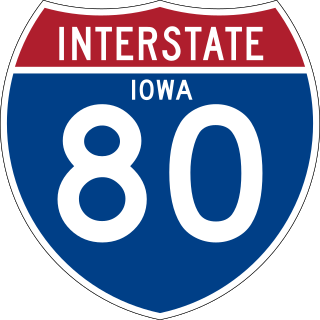
Interstate 80 (I-80) is a transcontinental Interstate Highway in the United States, stretching from San Francisco, California, to Teaneck, New Jersey. In Iowa, the highway travels west to east through the center of the state. It enters the state at the Missouri River in Council Bluffs and heads east through the southern Iowa drift plain. In the Des Moines metropolitan area, I-80 meets up with I-35 and the two routes bypass Des Moines together. On the northern side of Des Moines, the Interstates split and I-80 continues east. In eastern Iowa, it provides access to the University of Iowa in Iowa City. Northwest of the Quad Cities in Walcott is Iowa 80, the world's largest truck stop. I-80 passes along the northern edge of Davenport and Bettendorf and leaves Iowa via the Fred Schwengel Memorial Bridge over the Mississippi River into Illinois.

Iowa Highway 160 (Iowa 160) is a short state highway that runs east and west in central Iowa. Its begins at Iowa 415 in Ankeny and ends at exit 90 of Interstate 35 (I-35) in Ankeny. Originally ending at a Y intersection, south of the current intersection with Iowa 415, the route has been straightened to run west and east. Iowa 160 passes Des Moines Area Community College near its intersection with U.S. Highway 69 (US 69).

Iowa Highway 316 (Iowa 316) is a 5.183-mile-long (8.341 km) spur route in central Iowa. The route begins at Iowa Highway 5 south of Swan and ends at the eastern city limits of Runnells. Prior to 2003, Iowa 316 extended north to Iowa Highway 163 north of Runnells, but that portion was turned over to Polk County. The highway's primary purpose is a crossing of the Des Moines River south of Runnells.
The bypass around Des Moines, Iowa, is a 25-mile-long (40 km) freeway around the south and east of the Des Moines metropolitan area. The route is made up of two state highways – Iowa Highway 5 (Iowa 5) and U.S. Highway 65 (US 65). The bypass begins in southwestern West Des Moines at Iowa 5's interchange with Interstate 35 (I-35). It heads to the east and then curves to the north near the southeastern side of Des Moines. It ends at the interchange of US 65 and I-80 in Altoona.
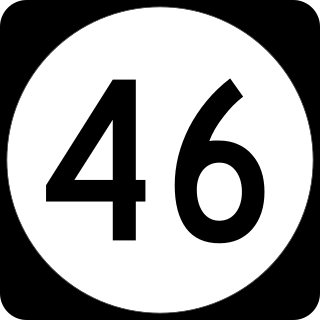
Iowa Highway 46 (Iowa 46) was a state highway in Polk County, Iowa. It began at an intersection with Iowa 5 near Avon. It traveled north and west through the industrial section of southeastern Des Moines. It ended at Iowa 163, also known as E. University Avenue, in Des Moines next to the Iowa State Fairgrounds.

Iowa Highway 60 was a 223-mile-long (360 km) state highway that ran from the Missouri state line near Cincinnati, where it continued as Route 5, to U.S. Highway 18 (US 18) near Wesley. The highway passed through Centerville, Knoxville, Des Moines, and Webster City during its trek. It was an original state highway that was in service for 48 years. The highway originally only extended from Des Moines to Goldfield, but was extended in 1931. At that time, it absorbed Iowa Highway 6. On January 1, 1969, the highway ceased to exist. The Iowa State Highway Commission renumbered several state highways in order to match up route numbers with adjacent state highways. It was replaced by Iowa 5 south of Des Moines and Iowa 17 north of Granger.
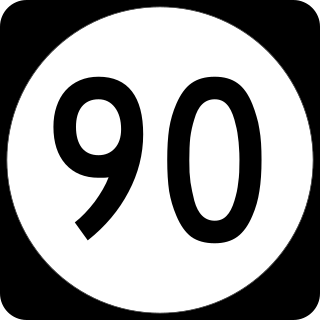
Iowa Highway 90 was a state highway in central Iowa. The highway was in service to traffic from 1932 through 1981 and took several forms over the years. It began as a spur route from Des Moines to Commerce, now part of West Des Moines. At its greatest extent, it extended from Atlantic to Newton along the historical routing of U.S. Highway 6 (US 6). From 1966 through 1981, the highway existed in its final form—from Interstate 80 (I-80) between Earlham and DeSoto to I-35 on the southern outskirts of West Des Moines.





















